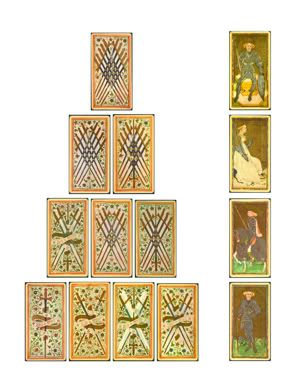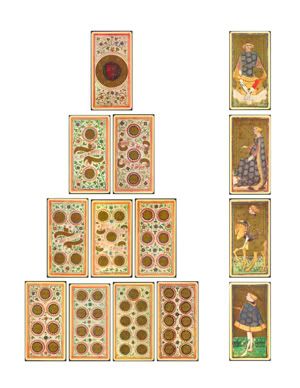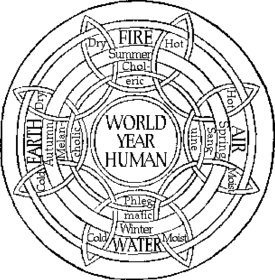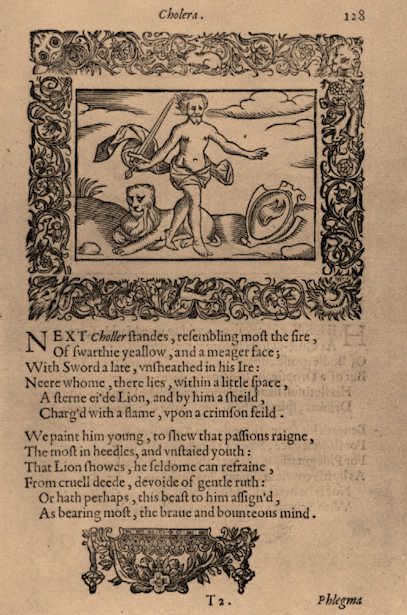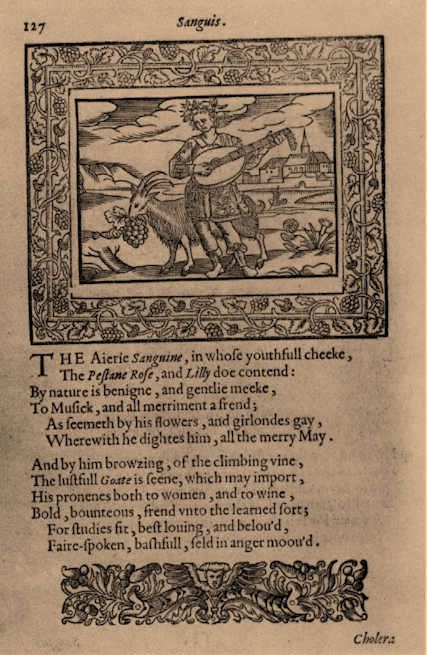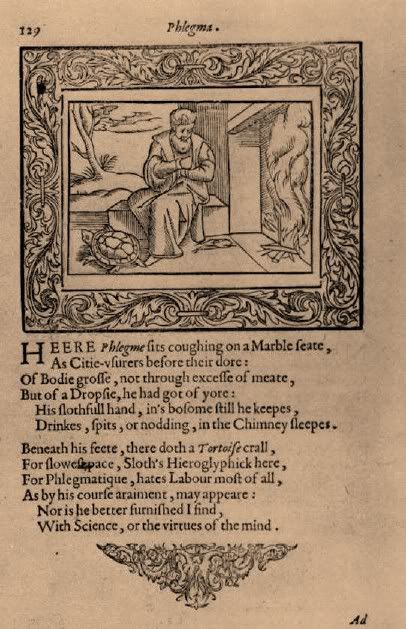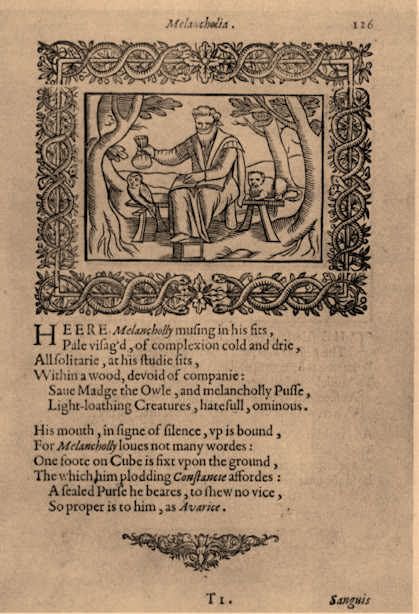Why Mel, Why? Episode 3 - What Do The Four Elements Mean?
THE FOUR ELEMENTS AND TEMPERAMENTS
The classical Four Elements are a great tool for seeing how energies work. Unfortunately there is a lot of misunderstanding about what they are, and how they work. If we wish to apply this brilliant and ancient system to the four Tarot suits, we first need to understand what the elements actually are.
The classical Four Elements are called Fire, Air, Water, and Earth. The names of the classical elements however, are not
literally describing actual fire, air, water. earth, but certain metaphysical qualities, which from the time of the ancient Greeks have described
specific tendencies in the way energies operate in the cosmos, and how these energies manifest in the mundane world. So, when an astrologer or alchemists or Medieval physician spoke of the Moon as 'Watery", or someone having a 'Watery" Phlegmatic constitution, they weren't thinking of actual physical water at all. They were talking about a specific range of qualities or behaviors. The universality of the classical Elemental system comes from how basic qualities have been connected, say
heat/speed/expansion/separation for example, and applied to a broad spectrum of things. As qualities, the elements are best approached as
adjectives or
adverbs, and not nouns.
Each of the four Elements is a combination of two of four even more basic qualities which are called "Powers". The Powers, like the Elements are not talking about actual substances, but are 'code words' for a collection of related qualities that share certain behaviors, and should be thought of as adjectives and adverbs too.
John Opsopaus explains the Powers,
"The four qualities are the key to understanding the rotation of the elements and many other applications of the symbology of the four elements. Since the elements are such rich symbols, one expects there must be more to the qualities than mundane heat, cold, moistness and dryness, and in fact Aristotle explains them quite abstractly.
The Hot, he says, is the power of separation, for it causes each substance to cling to its own kind, as occurs in distillation; that is, it dissociates a compound by associating things of the same kind. Conversely, the Cold associates things of different kinds, and allows substances to mix together. As a consequence, the Hot makes things subtle, light, rising and centrifugal, since substances must move away from the center to separate from each other. Conversely, the Cold makes things gross, heavy, falling and centripetal, since substances mix when forced to the center.
Aristotle explains that Moistness is the quality of fluidity or flexibility, which allows a thing to adapt to its external conditions, whereas Dryness is the quality of rigidity, which allows a thing to define its own shape and bounds. As a consequence Moist things tend to be volatile and expansive, since they can fill spaces in their surroundings, whereas Dry things are fixed and structured, since they define their own form.
The abstract character of the qualities also determines the relative subtlety of the elements. Since Dryness is self-determining, Fire and Earth have an absolute impulse to go in their own direction (centrifugal or up for Fire, centripetal or down for Earth). This is especially the case for Earth, which is predominantly Dry and self-determining, and so defines a basis for the other elements. The Hot quality dominates Fire, which explains why Fire and Heat have practically the same effect, for Heat expresses itself fully in Fire.
Since Moistness is sensitive to external conditions, Air and Water are not unswerving in their motion; their upward and downward tendencies are moderated by the expansive, spreading character of Moistness. Thus, while Fire and Earth are absolutely Light and Heavy, respectively, Air and Water are only relatively Light and Heavy. Centripetal Coldness dominates Water, which therefore tends to relax or sink into its surroundings. Moistness, which is expansive, dominates Air, which therefore tends to spread actively.
Therefore, in addition to their oppositional structure, the elements fall in a series of increasing subtlety: Earth, Water, Air, Fire. Systematic application of the elements should take account of both structures, oppositional and graded, or circular and linear.
Of course, any pair of opposed qualities can be associated with Hot/Cold and Moist/Dry, just as any series of four can be identified with the elements, but the result may have little similarity to earth, water, air and fire. If, however, the qualities are assigned in accord with Aristotle's abstract definitions, then the elements will be earthy, watery, airy and fiery, and their character and behavior will correspond to our intuitions."
(from
Rotation of the Elements http://www.cs.utk.edu/~mclennan/BA/RE.html )
- Fire - Elemental Fire is a combination of Heat and Dryness. It divisive and rigid, quick reacting and long of duration. It rules Summer, Noon time, South, and the ages between 14 - 28. In Astrology it is associated with the Sun, and Mars.
- Water - Elemental Water, being Cold and Moist is uniting and flexible, slow reacting and short of duration. It rules Winter, Midnight, North, and the ages between 56 - Death. In Astrology it is associated with the Moon, some aspects of Venus, and some aspects of Mercury.
- Air - Elemental Air is Hot and Moist, flexible, fluid, but separating and expansive, quick reaction, but of short duration. It rules Spring, Dawn, East, and the ages between 0 - 14. In Astrology it is associated with Jupiter, and some aspects of Venus.
- Earth - Elemental Earth is Cold and Dry. Relating, purposeful, slow reacting and long of duration. It rules Autumn, Dusk, West, and the ages between 28 - 56. In Astrology it is associated with Saturn.
The idea of the Four Temperaments grew out of the Four Elements and their association to four bodily fluids, called the Humors. Basically the Four Temperaments are how the Elements manifest in the human conditions.
FIRE = CHOLERIC
In the fiery character of the Choleric, the fast reaction time is manifested as impulsiveness, decisiveness, quickness to anger, and mental quickness at grasping ideas. The long duration manifests as vindictiveness, ability to see those quick decision through, a sense of pride and honor, and a need to control. This makes Cholerics the aggressive, controlling people they are, and they are the people who rise up to be leaders.
In the airy character of the Sanguine, the fast reaction time is manifested also as impulsiveness, quickness at grasping ideas, enthusiasm and wit. The short duration means that the Sanguine won’t hold grudges however. It also gives the Sanguine the tendency to get bored easily, and be fickle and restless.
In the watery character of the Phlegmatic, the slow reaction time manifests as calmness, frugality, and indecisiveness. The short duration makes the Phlegmatic lazy, timid, hesitant and conservative.
In the earthy character of the Melancholic, the slow reaction time manifests as cautiousness, indecision, irresolution and being withdrawn. The long duration makes the melancholic introspective, deep, penetrating, unforgiving, and a tendency to dwell in the past.



